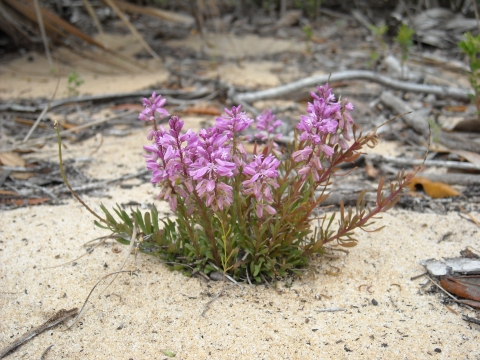About Us
The Lake Wales Ridge National Wildlife Refuge was established in 1993 as the first refuge designated for the recovery of endangered and threatened plants. The refuge contains 23 listed plants, at least four listed animals, and more than 40 endemic invertebrates. It is part of a network of scrub preserves owned by the state of Florida, The Nature Conservancy, Archbold Biological Station, two water-management districts and Polk and Highland counties.
The refuge is composed of four tracts within Polk and Highlands counties. Because of the potential impact to the plants and animals, the refuge has not been opened to the public. However, this refuge is an exciting place where researchers from Archbold Biological Station have conducted important ecological studies. Per acre, the refuge has a very high density of listed species.
The refuge is exciting because it contains prime examples of several highly imperiled ecosystems, including Florida scrub and sandhill, as well as over half of the federally listed plant species endemic to the Lake Wales Ridge. Each of the four tracts comprising the refuge has its own particular merits and value:
Carter Creek is an excellent example of endemic-rich Lake Wales Ridge sandhill, with nine listed plants and it contains one of only a dozen populations of Florida ziziphus (Ziziphus celata), one of the rarest and most endangered plants in the state. Flamingo Villas has 10 listed species and has the only protected populations of Garrett’s scrub balm (Dicerandra christmanii), a woody mint known only from Highlands County. Lake McLeod has 11 listed plants and is the only protected site for scrub lupine (Lupinus aridorum), another extremely rare plant and, Snell Creek contains one of the last remaining tracts of undisturbed sandhill in northern Polk County.
Our Mission
Each unit of the National Wildlife Refuge System is established to serve a statutory purpose that targets the conservation of native species dependent on its lands and waters. All activities on those acres are reviewed for compatibility with this statutory purpose.
The purposes of Lake Wales Ridge National Wildlife Refuge is. . .
"... for use as an inviolate sanctuary, or for any other management purpose, for migratory birds." 16 U.S.C. § 715d (Migratory Bird Conservation Act)
"... suitable for— (1) incidental fish and wildlife-oriented recreational development, (2) the protection of natural resources, (3) the conservation of endangered species or threatened species ..." 16 U.S.C. § 460k-1 "... the Secretary ... may accept and use ... real ... property. Such acceptance may be accomplished under the terms and conditions of restrictive covenants imposed by donors ..." 16 U.S.C. § 460k-2 (Refuge Recreation Act (16 U.S.C. § 460k-460k-4), as amended).
Our History
1903: On March 14, with the encouragement of Frank Chapman and the Florida Audubon Society, President Theodore Roosevelt established Pelican Island in the Indian River Lagoon as the first federal bird reservation giving birth to the National Wildlife Refuge System. Audubon hired Paul Kroegel as the first warden of Pelican Island. By the end of his presidency, Roosevelt named nine more reservations in Florida and a total of 55 bird reservations and national game preserves, the forerunner to the National Wildlife Refuge System.
1956: Congress passed the Fish and Wildlife Act, creating a comprehensive national fish and wildlife policy and providing authority to acquire and develop lands for national wildlife refuges.
1991: The state of Florida has made Lake Wales Ridge NWR one of their highest priority purchases and is purchasing 10 tracts. The Nature Conservancy, Archbold Biological Station and Bok Tower Gardens are private conservation landowners involved in the project. As land management programs were being developed mangers from the private, state and federal agencies recognized the need to coordinate and share information, planning, and problem solving across the landscape. To this end, the Lake Wales Ridge Ecosystem Working Group was established.
1994: The U.S. Fish and Wildlife Service (Service) purchased its first scrub tract on the ridge, establishing the country’s first national wildlife refuge for endangered plants. The Service is currently purchasing four tracts that may eventually total about 2,400 acres.
1996: The working group began developing an ecosystem management plan that includes fire management, species inventory and monitoring, development of GIS data sharing, and an ecosystem-wide community education and outreach plan.
1997: The National Wildlife Refuge System Improvement Act was established and signed into law by President Clinton on Oct. 9. It defined a unifying mission for all refuges, including a process for determining compatible uses on refuges, and requiring that each refuge be managed according to a CCP. The NWRS Improvement Act expressly stated that wildlife conservation is the priority of system lands and that the Secretary shall ensure that the biological integrity, diversity, and environmental health of refuge lands are maintained. Each refuge must be managed to fulfill the specific purposes for which the refuge was established as well as the system mission. The first priority of each refuge is to conserve, manage, and if needed, restore fish and wildlife populations and habitats according to its purpose.
Other Facilities in this Complex
Lake Wales Ridge National Wildlife Refuge is managed as part of the Everglades Headwaters National Wildlife Refuge Complex.

